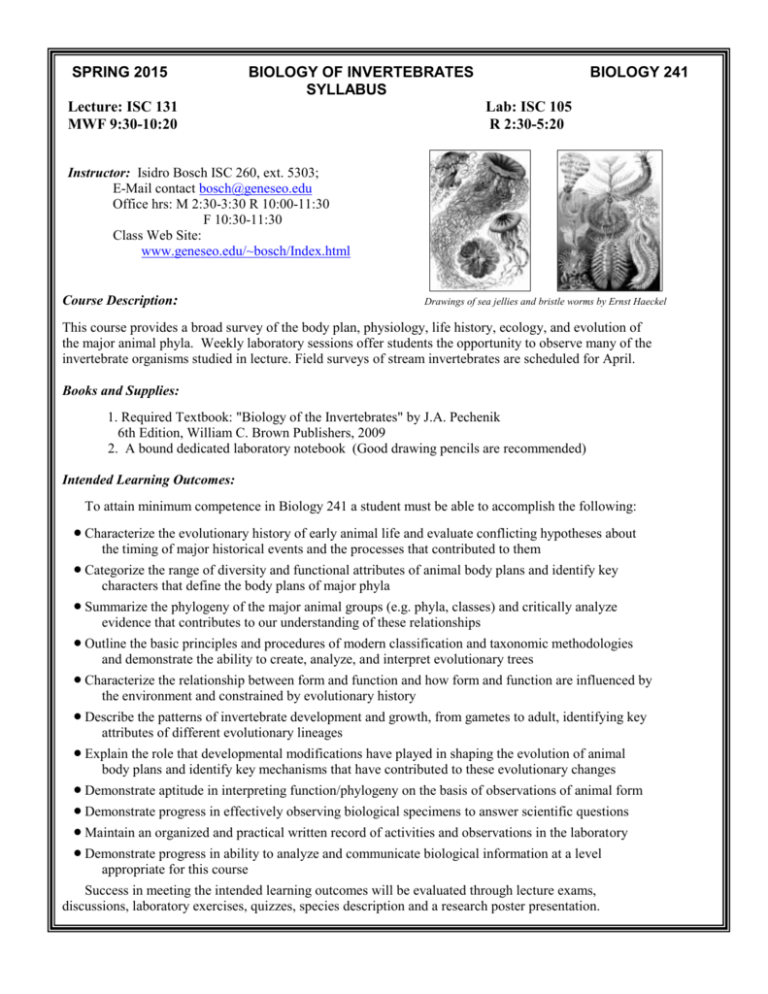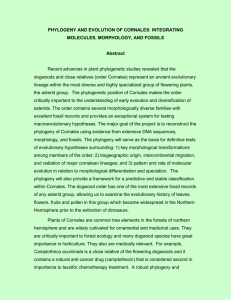SyllabusS15
advertisement

SPRING 2015 BIOLOGY OF INVERTEBRATES SYLLABUS Lecture: ISC 131 MWF 9:30-10:20 BIOLOGY 241 Lab: ISC 105 R 2:30-5:20 Instructor: Isidro Bosch ISC 260, ext. 5303; E-Mail contact bosch@geneseo.edu Office hrs: M 2:30-3:30 R 10:00-11:30 F 10:30-11:30 Class Web Site: www.geneseo.edu/~bosch/Index.html Course Description: Drawings of sea jellies and bristle worms by Ernst Haeckel This course provides a broad survey of the body plan, physiology, life history, ecology, and evolution of the major animal phyla. Weekly laboratory sessions offer students the opportunity to observe many of the invertebrate organisms studied in lecture. Field surveys of stream invertebrates are scheduled for April. Books and Supplies: 1. Required Textbook: "Biology of the Invertebrates" by J.A. Pechenik 6th Edition, William C. Brown Publishers, 2009 2. A bound dedicated laboratory notebook (Good drawing pencils are recommended) Intended Learning Outcomes: To attain minimum competence in Biology 241 a student must be able to accomplish the following: Characterize the evolutionary history of early animal life and evaluate conflicting hypotheses about the timing of major historical events and the processes that contributed to them Categorize the range of diversity and functional attributes of animal body plans and identify key characters that define the body plans of major phyla Summarize the phylogeny of the major animal groups (e.g. phyla, classes) and critically analyze evidence that contributes to our understanding of these relationships Outline the basic principles and procedures of modern classification and taxonomic methodologies and demonstrate the ability to create, analyze, and interpret evolutionary trees Characterize the relationship between form and function and how form and function are influenced by the environment and constrained by evolutionary history Describe the patterns of invertebrate development and growth, from gametes to adult, identifying key attributes of different evolutionary lineages Explain the role that developmental modifications have played in shaping the evolution of animal body plans and identify key mechanisms that have contributed to these evolutionary changes Demonstrate aptitude in interpreting function/phylogeny on the basis of observations of animal form Demonstrate progress in effectively observing biological specimens to answer scientific questions Maintain an organized and practical written record of activities and observations in the laboratory Demonstrate progress in ability to analyze and communicate biological information at a level appropriate for this course Success in meeting the intended learning outcomes will be evaluated through lecture exams, discussions, laboratory exercises, quizzes, species description and a research poster presentation. Evaluation**: 1. Lecture exams: 3 semester exams, 12%, 14%, and 16% of the final grade and a final exam worth 10% 2. Group Projects (descriptions below) Poster presentation (10 %), Species Description (6 %) 3. Contributions to class and laboratory activities/discussions (5 %) 4. Laboratory quizzes (12%) and laboratory notebook (5 %) 5. Homework assignments (10 % four assignments) **Make-up exams or assignments may be scheduled at the discretion of the instructor when legitimate written medical or personal justification is provided. There are no provisions for making up laboratory activities. Field outings postponed due to weather may be rescheduled outside of the regular lab period. Laboratory Syllabus The Biology 241 laboratory provides an opportunity for students to observe many of the organisms studied in lecture. Students are expected to participate in dissections of fixed or anesthetized animals. Those with legitimate personal conflicts that preclude participation in dissections may be assigned alternative activities. The instructor must be made aware of these conflicts at the beginning to the semester to allow ample time for preparation of alternative activities. Other activities planned for the laboratory meetings include work on collaborative projects and field trips to observe animals in their natural habitats. Participation in class field trips is expected. Quizzes and exercises will test student knowledge of the organisms studied in the laboratory. Due to the difficulty of setting up laboratories, no make-up labs or lab quizzes can be scheduled. Students are expected to keep a neat, organized, and informative laboratory notebook containing a record of significant concepts and observations. The notebook should include primarily original drawings and observations (not copied from books). Original diagrams and notes in the lab notebook can be used as a reference during laboratory quizzes. This is a privilege that may be revoked if students are found to be copying information directly from other sources into their lab notebook. A pre-lab summary of the planned activities should be completed in the lab notebook prior to each lab meeting. Date Jan. Tentative Laboratory Schedule 22 29 Feb 5 12 19 26 Mar 5 12 19 26 Apr 2 9 16 23 30 Topic _____ Assigned Reading Orientation/Observation Phylogenetic Analysis (Lab Guide #1) Protista and Sponges (Guide #2) Cnidaria (Guide #3) Embryology (Guide #4) Parasitism (Quiz #1: Embryology) (Guide #5) Molluscs I (Quiz #2: Parasitism) (Guide #6) Molluscs II (Quiz #3: Molluscs) Spring Recess Annelid Diversity (Quiz #4: Annelids) (Guide #7) Arthropods I: Crustacea (Quiz #5 Crust) (Guide #8) II: Insects (Quiz #6 Insects) (Guide #9) Stream Invertebrates Field Trip Poster Session Stream Invertebrates Project Group Projects Students must complete two major projects to pass this course. Each project will cultivate particular process skills needed in the study of biology while emphasizing different aspects of animal diversity. All projects will be collaborations. Project groups and topics must be pre-approved by the instructor. Below is a brief initial description of each project. More details are to be provided during the semester. Project #1: Poster Presentation (10% of total Score, due Thursday April 23) For this assignment students will explore a question in the areas of phylogeny (taxonomic classification, relationships between different groups), evolution or comparative function and form of invertebrates. The information presented in the poster should be from the peer-reviewed technical scientific literature (journal articles) and must include at least 5 such sources. Internet sources are acceptable only as supplements to the primary literature. The tentative date for the poster presentation is during the lab meeting on April 24. That same day you must turn in a 2 page written summary of your presentation, a bibliography, and copies of two key references used. Your grade in this assignment will be determined by the organization, content and effort dedicated to the project. More specific guidelines will be provided later in the semester. Peer-reviews will be incorporated into the final evaluation. Project #2: Description of Stream Invertebrate Species (6 % of score due Monday May 4) For this project you will collect and identify (using taxonomic keys) an invertebrate species from local habitats and submit a formal written description of the species of no more than 5 pages. Examples of successful species descriptions from previous years and a grading rubric for the assignment will be provided. The report will be graded on overall organization, the accuracy of the description and accuracy in the identification of a species. To complete the project each group must submit a representative specimen preserved in 70% ethanol and stored in a vial labeled with the taxonomic order and species name, date, and the name of at least one student who participate in the identification. Caribbean long-spined sea urchin. Phylum Echinodermata Diadema antillarum Tentative Lecture Schedule (Regularly updated on class web site: http://www.geneseo.edu/~bosch/Index.html (select “Lectures in pdf format”) # Date Topic Readings____________ ^names in italics are references to articles posted on line 1 Jan 21 W 2 23 F 3 26 M 4 28 5-6 30 Feb 2 M 7 4 8 6 9-10 M- 9 11 11 13 Course Introduction and Planning Animal Diversity Protists Classification and Phylogeny Evolutionary History of the Metazoa Porifera and Placozoa Cnidaria: Body Plan; Scyphozoa Hydrozoans/Anthozoans. Coral Reef Ecology 12 Exam I (Lec 1-11) 16 M 13 18 14 20 15-16 M 23, 25 17 27 18 Mar 2 M 19 4 20-21 6-9 M Embryogeny and Phylogeny Ctenophores Flatworms / Challenges of Parasitism Nemertines and Body Cavities Animal Body Plan Evolution Mollusca Body Plan Molluscan Radiation 22 11 Exam II (Lec 13-21) 23 13 Light Detection and Vision 16-20 Spring Recess 24 25-26 27 28 29-30 31-32 33 34 35 23 M 25-27 30 M April 1 3 -6 M 8-10 13 M 15 17 Ch 2: 7-16 Ch 7 Ch 8:149-156; 157-170 Ch 11 Nielsen Ch 12: 215-222 224-238; 239-264 Oakley (Hwk #3 Due 3/23) Light Detection and Vision Annelid Body Plan, Diversity Arthropods: Introduction Arthropod: Crustacea Arthropod: Mandibulates Insects and flight Arthropod Chelicerates Nematodes /Exam Review Ch 13 : 295-312; 318-325 Ch 14: 342-350 : 374-392 : 358-373 Averof and Cohen; Hwk #4 Due 4/13 : 352-357 Ch 16 Exam III (Lec 23 -34) 36-37 M-20, 22 38 24 39-41 27 –29, May 1 42 4 Echinoderms Reproductive Strategies Hemichordates and Chordates Overview/Review for final exam 43 Final Exam (8-11 AM) 13 W Preface, Ch 1 Ch 3: 37-42, 58-61 Ch 2: 16-29; Hwk #1 Due 2/2 Sukumaran Ch 4:79-91 Hwk #2 Due 2/6 Ch 6: 101-110 110-117, 118-127 Muscatine Ch 20: 497-509; 509-520 Ch 24: 567-580 Ch 21, 23 Arrow Worm, Phylum Chaetognatha







